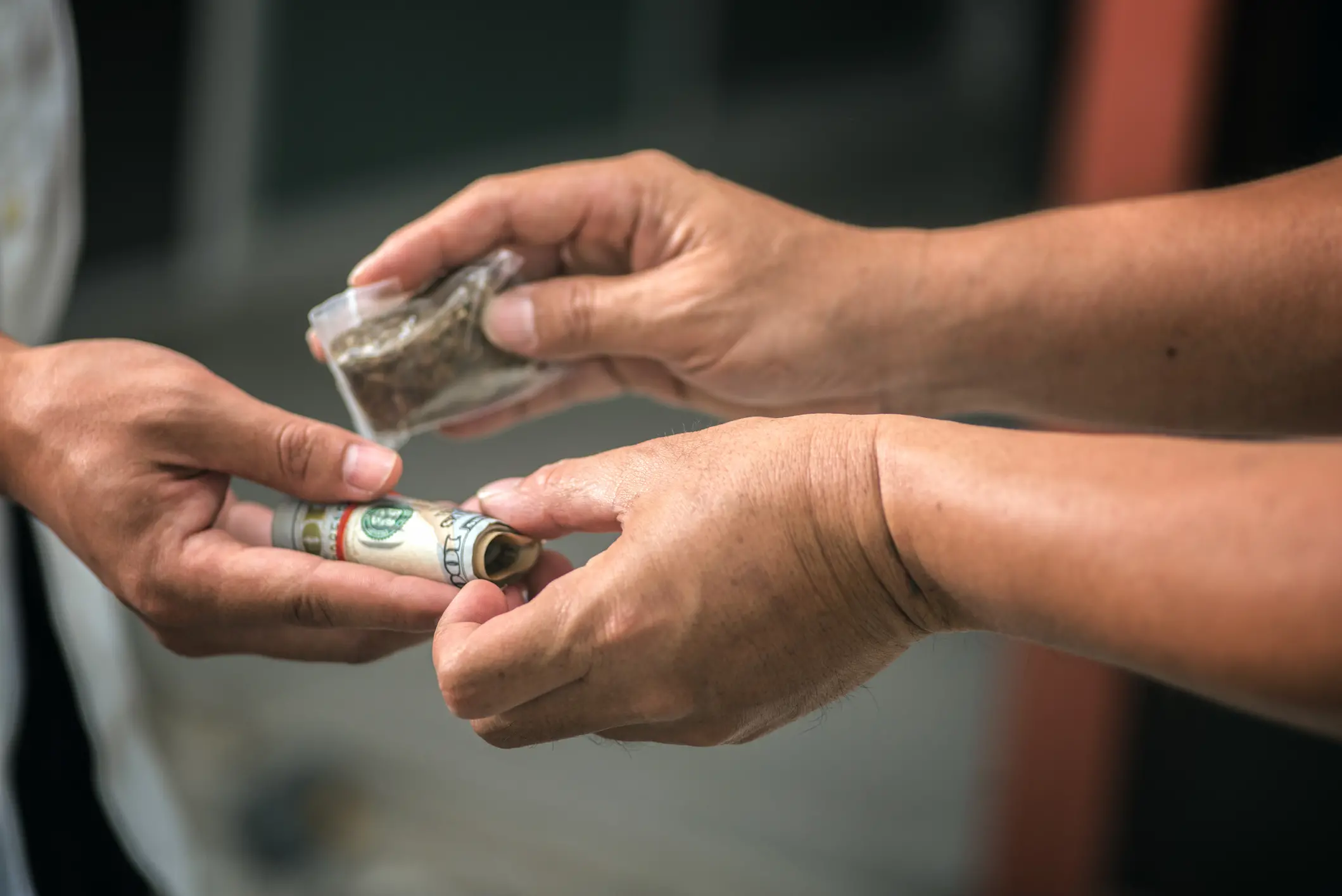
Some drugs produce a long-lasting effect while others are short-acting. If a drug’s effects wear off quickly, a person is likely to take more frequent doses or mix it with other drugs.
Over time, the body gets used to a certain dosage and the drug begins to have less of an effect. Tolerance leads to higher doses, also increasing the cost of abuse.
Someone with a high tolerance who is living with addiction will take multiple doses in a day, racking up the cost to hundreds or even thousands of dollars each week.
How Much Does Heroin Cost?
Brown powder and black tar heroin run about $10 per gram, while white powder is $15 to $20 per gram. The darker colors indicate impurities, so brown powder and black tar heroin are generally less expensive.
The type of heroin that is more prevalent depends on where it is located. Since black tar heroin comes from Mexico, it is more common in southern states.
An average dose of heroin is .1 gram. The euphoria produced by heroin lasts only a few minutes, but the following sense of calm and relaxation can last for three to five hours after use.
How Much Does Cocaine Cost?
A gram of cocaine can cost anywhere from $60 to $150. The cost is highly dependent on purity and location of sale, however.
Cocaine is sold on the street as a white powder or rock-like substance called crack cocaine. Studies have found that more wealthy people purchase powdered cocaine while those with lower incomes tend to buy crack cocaine.
An average dose of cocaine is 50 to 100 mg. Cocaine is often measured in lines (for snorting), and there are about 10 to 20 lines per gram. The high from cocaine use is short, lasting only five to 30 minutes.
How Much Does Methamphetamine Cost?
A gram of crystal meth costs $20 to $60. Methamphetamine may come as a powder, but it is most frequently sold in crystal form.
The rise in home methamphetamine labs in the U.S. has increased drug traffic and decreased prices. The Drug Enforcement Administration (DEA) notes that the average price per gram dropped from $98 to $58.
A dose of methamphetamine is .1 to .25 grams and the effects generally last six to eight hours, though some people feel it for much longer.
How Much Does Marijuana Cost?
While many states allow medical marijuana, not all states have approved recreational use. As a result, marijuana is still sold on the street. It comes in different forms for different prices.
The following are different ways people buy marijuana:
Synthetic cannabinoids, sometimes called “fake marijuana,” are generally less expensive. Spice and K2 (two variations) cost about $10 per gram.
A joint, blunt, or edible is a single dose. A dose of cannabis may be .1 to .5 grams while a dose of oil starts at 25 mg. The effects from smoking bud or oil may last a half hour to 1.5 hours, while the effects of edibles may linger for several hours.
How Much Do Synthetic Cathinones Cost?
Synthetic cathinones can cost $25 to $50 per 50 mg packet. An average dose ranges from five to 20 mg. These stimulant drugs are sold in packages labeled “bath salts” and “plant food,” so they are easier to sell undetected.
The stimulant effects are generally followed by a crash, and the whole effect lasts six to eight hours.
The Street Prices Of Hallucinogens And Club Drugs
Hallucinogens are drugs that intensify the senses and alter the mind. Some of these are called “club drugs” because they are commonly used at nightclubs, parties, and concerts.
Not all club drugs have hallucinogenic effects.
Factors That Determine The Average Cost Of Illegal Drugs
The average cost of illegal drugs on the street is also affected by location. Cities with high populations tend to have more people buying drugs in them.
This demand allows for prices to be lower than in a rural area where there are not many buyers. Big cities are also likely to have more drug dealers, and competition can keep prices low.
Certain cities in the United States are hubs for Mexican drug cartels. Drugs are trafficked into these cities from Mexico and distributed throughout the United States.
As a result, these cities are populated with drugs such as heroin, cocaine, and methamphetamine. More supply means lower prices, whereas drugs cost more in places that do not have as much drug traffic.
The purity of drugs also affects the cost. Illegal drugs are usually cut with substances that are similar in appearance.
Some cutting agents are harmless. Others, such as fentanyl, are deadly. Buyers do not always know what is mixed into the drugs they get on the street.
The result may be unexpected overdose or negative health effects due to adulterants that shouldn’t be ingested.
Other factors that may influence illicit drug prices:
- drug trafficking and the local drug market
- law enforcement policies
- location in America (California, New York, Florida, etc.)
- cutting agents such as synthetic opioids, benzodiazepines, amphetamines
- regulations on prescription drugs, including prescription opioids
- affordability
- public health policies
- how policymakers are addressing illicit drug use
The Personal And Societal Costs Of Illegal Drugs On The Street
The cost of illicit substances on the street is not just about how much a person has to pay for the drugs. If someone overdoses or engages in dangerous behavior while intoxicated, they may end up in the hospital.
The healthcare costs associated with illicit drug abuse are high.
There is also a cost to society when individuals are incarcerated for drug-related crimes. These crimes include drug possession, trafficking, and violent acts committed during drug deals or as a result of the drug’s effects.
A recent study of heroin use disorder in the U.S. found that the annual societal cost of related healthcare and incarcerations is around 51.2 billion dollars.
Then there are the costs that are harder to measure. Drug addiction can take hold quickly and dramatically alter a person’s quality of life.
Addiction has a lofty emotional cost for the individual as well as for their family and friends, and may cause:
- damaged relationships
- destroyed trust
- emotional pain
- job loss
- drug overdose
- financial ruin
- homelessness
- physical and mental health problems
When someone is living with addiction, consuming the drug becomes more important than anything else. A substance use treatment center can help people take back control of their life.
Drug Addiction Treatment Options
The best addiction treatment programs meet people where they are. They work with each individual to create a unique recovery plan for their needs.
Addiction treatment services may include:
- medical detoxification
- medication-assisted treatment (MAT)
- group therapy
- 12-step recovery groups
- behavioral therapy
Individualized treatment gives people the best chance at overcoming issues that contribute to their drug use so they can avoid relapse.
Drug addiction treatment can take place in an outpatient or inpatient setting. Residential treatment programs offer a home-like environment that removes a person from the streets where they used to buy drugs.
Find Substance Use Disorder Treatment Programs Today
Reach out to our team at AddictionResource.net today for more information about drug and alcohol treatment options.
Addiction Resource aims to provide only the most current, accurate information in regards to addiction and addiction treatment, which means we only reference the most credible sources available.
These include peer-reviewed journals, government entities and academic institutions, and leaders in addiction healthcare and advocacy. Learn more about how we safeguard our content by viewing our editorial policy.
- The New England Journal of Medicine - "Bath Salts" Intoxication
https://www.nejm.org/doi/full/10.1056/NEJMc1107097 - U.S. Drug Enforcement Administration - 2017 National Drug Threat Assessment
https://www.deadiversion.usdoj.gov/drug_chem_info/index.html - U.S. Drug Enforcement Administration - Drug and Chemical Information
https://www.deadiversion.usdoj.gov/drug_chem_info/index.html


